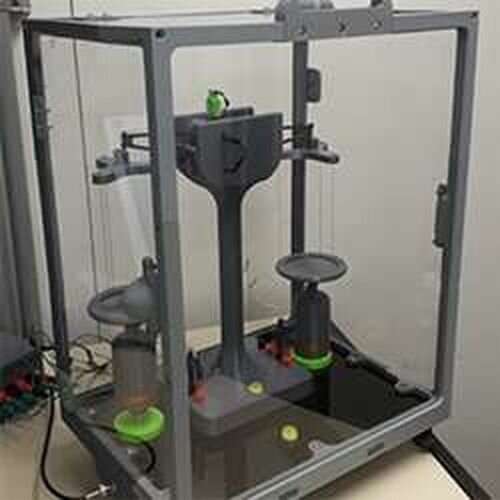Credit: National Physical Laboratory
In 2019, the International System of Units (SI) was redefined in terms of constants that relate to the natural world. This assures the future stability of the SI and opens the opportunity for the use of new technologies, including quantum technologies, to implement the new definitions. This ever-improving accuracy needs to be enabled by stable measurement standards underpinned by agreed definitions of measurement units.
The kilogram is now defined in terms of the Planck constant, which is a fundamental constant of nature, and can be realized using the Kibble balance, formerly the watt balance, and renamed after Bryan Kibble who developed the apparatus at NPL in the 1970s. NPL's Mass group, in collaboration with the Laboratory of Ultrasound at INMETRO, Brazil, have designed and built a prototype bench-top Kibble balance to perform reference level ultrasonic power measurements, which are currently undertaken using a conventional mass balance.
This prototype radiation force balance (RFB) makes measurements of ultrasonic power directly traceable to the SI unit of mass, as realized via a fixed value of the Planck constant. The new technique for ultrasonic power measurement nullifies the need to measure local gravity acceleration and allows ultrasonic power to be measured anywhere on earth without the need to make gravitational corrections.
Ultrasound is widely used for industrial and medical purposes. In industry, it is used to test high-value manufactured components (e.g., for aircraft parts). In medical applications it is used for therapeutic purposes, for heating, ablating or fragmenting tissue, and diagnostics, which is capable of obtaining non-invasive images of the internal organs of the body.
One of the most common uses of ultrasound is during pregnancy, to monitor the development of the fetus, but it can also be used to generate images of the heart, blood vessels, eyes, thyroid, breast, muscles and so on. Therefore, the output power level must be accurately measured for reasons of safety and efficiency. Current traceability uses a conventional mass balance, validated with standard weights, to calibrate primary ultrasonic power meters with typical uncertainties of about 7%.
Consequently, the application of Kibble balance technology in this area has the potential to simplify the traceability chain and improve the repeatability and accuracy of ultrasonic power meter calibration. More accurate measurement facilitates create advances in science and technology, which in turn allows more accurate measurement.
Stuart Davidson, principal research scientist, NPL said, "This is a great example of how next-generation technologies, enabled by the new SI base unit definitions, can be used to simplify measurement and improve accuracy at the end-user level."
Emily Webster, higher research scientist, NPL said, "It was a pleasure to contribute to the introduction of Kibble balance technology in the field of ultrasonic power measurement. This is a step forward in reducing the length of traceability chains in this area by implementation of the new SI at the point of use. This project took place during the COVID-19 pandemic and its success highlights the creativity and commitment of the partners in overcoming the challenges of remote only interaction."
Ruan Mayworm, INMETRO scientist, said, "This work demonstrated the feasibility of using the Kibble balance principle to measure ultrasonic power, opening the door to the development of more precise and accurate ultrasonic power measurement systems with direct traceability to the SI. Furthermore, the good results obtained were only possible due to the collaboration between INMETRO and the NPL, thus demonstrating the importance of collaboration between the different National Metrology Institutes for the development of metrology worldwide."
Rodrigo Costa-Felix, head of the Laboratory of Ultrasound at INMETRO, highlighted the importance of such collaboration, "The relevance of the project is twofold. Firstly, we were able to prove the concept that Kibble balance can measure ultrasonic power with reasonable accuracy and precision. Secondly, it let clear that metrology is a science that very well benefits from multidisciplinary and multi-area interaction. NPL support in this regard was remarkable," he said.
Provided by National Physical Laboratory
























